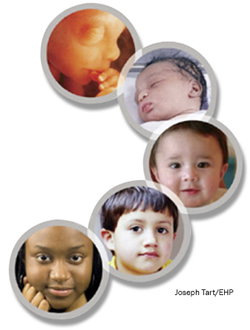Children's Diseases
Program Leads
-

-
Kimberly Ann Gray, Ph.D. (http://www.niehs.nih.gov/research/supported/dert/sphb/staff/gray/index.cfm)
Health Scientist Administrator -
P.O. Box 12233
Research Triangle Park, North Carolina 27709
Tel (919) 541-0293
Fax (919) 316-4606
gray6@niehs.nih.gov
-

-
Annette Kirshner, Ph.D. (http://www.niehs.nih.gov/research/supported/dert/cospb/staff/kirsher/index.cfm)
Program Administrator -
P.O. Box 12233
Research Triangle Park, North Carolina 27709 Tel (919) 541-0488
Fax (919) 541-0462
kirshner@niehs.nih.gov
-

-
Cindy Lawler, Ph.D. (http://www.niehs.nih.gov/research/supported/dert/cospb/staff/lawler/index.cfm)
Acting Branch Chief -
Neuroscience
Division of Extramural Research and Training
P.O. Box 12233
Research Triangle Park, North Carolina 27709
Tel (919) 316-4671
Fax (919) 541-0462
lawler@niehs.nih.gov

Program Description
Protecting children’s health is a vital public health goal. Children are particularly vulnerable to the health effects of environmental toxins. The same amount of a contaminant, such as lead or air pollution, has a greater effect on a child than it does on an adult because children’s bodies are smaller. In addition, children go through critical periods during development when they are especially susceptible to the effects of contaminants. Children’s bodies also do not yet have fully-functioning systems to handle contaminants or rid the body of toxins.
What NIEHS is doing
NIEHS is committed to fostering a healthy environment for all children by advancing our understanding of how exposure to environmental toxins affects people’s health in childhood and throughout life. NIEHS supports a broad range of research focusing on contaminants children may encounter, such as pesticides, arsenic, tobacco smoke, mercury, bisphenol A (BPA), and many others. Researchers supported by NIEHS investigate how being exposed to such toxins in the womb or during childhood might contribute to developmental problems, childhood diseases, or the development of disease even years later. These researchers examine how environmental exposures may contribute to such health outcomes as asthma, autism, childhood leukemia, obesity, and diabetes.
Children’s health research efforts span many NIEHS program areas. Through its Centers for Children's Environmental Health & Disease Prevention Research, for example, NIEHS supports medium and long-term research projects to identify the health effects of environmental toxins on children. Scientists at these centers work with community partners and health care providers to reduce children’s exposure to toxins. In addition, NIEHS supports a variety of research projects through the National Toxicology Program, the Superfund Research Program, and other programs that apply the latest scientific innovations and approaches to protect children from harmful environmental contaminants.

